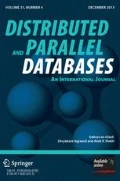Abstract
In intelligent networking telecommunication services such as free-phone and various personal communications services, the dialed number corresponds to the identity of the called party rather than to the called party's physical location. The dialed number must therefore be converted to a routable telephone number during call setup. This accomplished by querying a database. If the query is successful, its result is a routable number which is passed to the switch at which the call originates so that the call may be completed. A database maintained solely at a single node may not be sufficient to support the large capacity, reliability, and rapid processing requirements of this service. However, these requirements may be met by replicating and distributing the database instead.
Replication and distribution induce problems of consistency, concurrency, and load balancing. We describe and present a performance model of a scheme for replicating customer profiles efficiently. To spread the query transaction load, the database and its replicates could be distributed over a set of geographically distinct nodes. The database would be partitioned into as many disjoint fragments as there are nodes. Each fragment would be stored at two of the nodes, subject to the constraint that no pair of subsets would be stored at more than one node. This constraint ensures that the load which would have been carried by a failed node is spread to two other nodes instead of one, thus reducing the risk of overload in case of failure. We also use a performance analysis to arrive at heuristics for routing transactions within the database which attempt to minimize the query and update response times. For a particular implementation, the analysis suggests that READ or query transactions should be routed to the least loaded node of those holding the fragment of interest. By contrast, when strict locking of all copies is required while performing an update, WRITE or update transactions which are initiated at one node and repeated at the other should be routed to the more heavily loaded of the nodes to minimise overall response time.
Similar content being viewed by others
References
D. Agrawal and A. El Abbadi, “Storage efficient replicated databases,” IEEE Trans. on Knowledge and Data Eng., vol. 2, no. 3, pp. 342–352, 1990.
G.R. Ash, R.H. Cardwell, and R.P. Murray, “Design and optimization of networks with dynamic routing,” B.S.T.J., vol. 60, pp. 1787–1820, 1981.
G.R. Ash, J. Chen, A.E. Frey, and B.D. Huang, “Real-time network routing in a dynamic class-of-service network,” Proceedings of 13th International Teletraffic Congress, 1991, pp. 187–194.
D. Barbara, H. Garcia-Molina, and B. Kogan, “Maintaining availability of replicated data in a dynamic failure environment,” Proc. Sixth Symposium on Reliability in Distributed Software and Database Systems, 1987, pp. 177–187.
P.A. Bernstein, V. Hazilacos, and N. Goodman, Concurrency Control and Recovery in Distributed Database Systems, Addison Wesley, 1987.
A.B. Bondi, “A study of a state-dependent job admissions policy,” Performance Evaluation, vol. 15, pp. 133–153, 1992.
F. Bonomi, B.T. Doshi, J.S. Kaufman, T.P. Lee, and A. Kumar, “A case study of an adaptive load balancing algorithm,” Queueing Systems, vol. 7, pp. 23–49, 1990.
F. Bonomi and A. Kumar, “Adaptive load balancing in a nonhomogeneous multiserver system with a central job scheduler,” IEEE Trans. Computers, vol. 39, no. 10, pp. 1232–1250, 1990.
W. Cellary, E. Gelenbe, and T. Morzy, Concurrency Control in Distributed Database Systems, North Holland, Amsterdam 1988.
W. Cellary, E. Gelenbe, and T. Morzy, Concurrency Control in Distributed Database Systems, North Holland, Amsterdam, 1988.
S. Ceri and G. Pelagatti, Distributed Databases, Principles and Systems, McGraw Hill, 1984.
P.J. Denning and J.P. Buzen “The operational analysis of queueing network models,” Computing Surveys, vol. 10, no. 3, pp. 225–262, 1978.
P.J. Denning, T.D. Dennis, and J.A. Brumfield, “Low contention semaphores and ready lists,” Comms. ACM, vol. 24, no. 10, pp. 687–699, 1981.
D. Ferrari and S. Zhou, An Empirical Investigation of Load Indices for Load-balanced Applications, Performance 87, P.J. Courtois and G. Latouche (Eds.), pp. 515–528, 1987.
M. Fujioka, S. Sakai, and H. Yagi, “Hierarchical and distributed information handling for UPT,” IEEE Network Magazine, vol. 53, pp. 50–60, Nov. 1990.
H. Garcia-Molina, “Performance of update algorithms for replicated data,” UMI Research Press, 1981.
A.N. Habermann, “Introduction to operating system design,” SRA, Chicago, 1976.
H.-I. Hsiao and D.J. DeWitt, “Chained declustering: A new availability strategy for multiprocessor database machines,” Proc. 1990 IEEE 6th International Conference on Data Engineering, 1990, pp. 456–465.
H.-I. Hsiao and D.J. DeWitt, “A performance study of three highly available data replication strategies,” Distributed and Parallel Databases, vol. 1, no. 1, pp. 53–80, 1993.
G. Latouche, “Algorithmic analysis of a multiprogramming-multiprocessor computer system,” J.A.C.M., vol. 28, no. 4, pp. 662–679, Oct. 1981.
K.K. Leung, “An efficient approach to updating replicated databases in wireles and advanced intelligent networks,” Proc. Fifth Workshop: Third Generation Wireless Information Networks, Rutgers University, April 26–27, 1995.
D. McDonald and F. Kaudel, “Risk analysis ofr improving survivability,” Proc. IEEE Globecom 91, 1991, pp. 57.6.1–57.6.5.
M.F. Neuts, “The caudal characteristic curve of queues,” Adv. Appl. Prob., vol. 18, pp. 221–254, 1986.
J.F. Pâris and H. Garcia-Molina (Eds.), Second Workshop on the Management of Replicated Data IEEE Computer Society Press: Los Alamitos, California, 1992.
J.D. Ullman, Principles of Database and Knowledge Systems—Vol. I, Computer Science Press, 1988.
K.S. Watson, Performance Evaluation of Cyclic Service Strategies—A Survey, Performance'84, E. Gelenbe, (Ed.), Elsevier: North Holland, 1984.
W. Whitt, “Deciding which queue to join—some counterexamples,” Opns. Res., vol. 34, no. 1, pp. 55–62, 1986.
W. Winston, “Optimality of the shortest line discipline,” J. Appl. Prob., vol. 14, pp. 118–119, 1977
P.S. Yu and A. Leff, “On robust routing and load sharing,” ACM transactions on database systems,” vol. 16, no. 3, pp. 476–512, 1991.
Author information
Authors and Affiliations
Additional information
Recommended by: Amit Sheth
Rights and permissions
About this article
Cite this article
Bondi, A.B., Jin, V. A performance model of a design for a minimally replicated distributed database for database-driven telecommunications services. Distrib Parallel Databases 4, 295–317 (1996). https://doi.org/10.1007/BF00119337
Received:
Accepted:
Issue Date:
DOI: https://doi.org/10.1007/BF00119337




